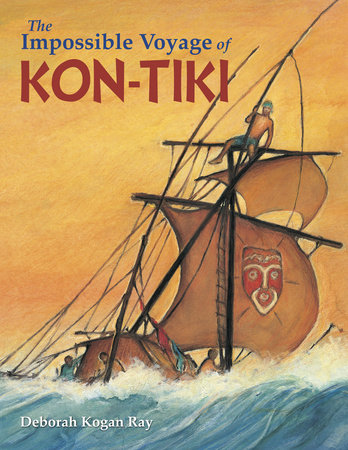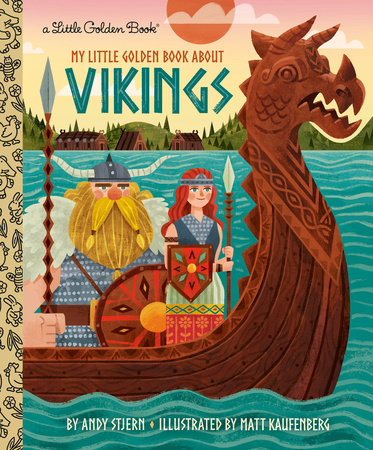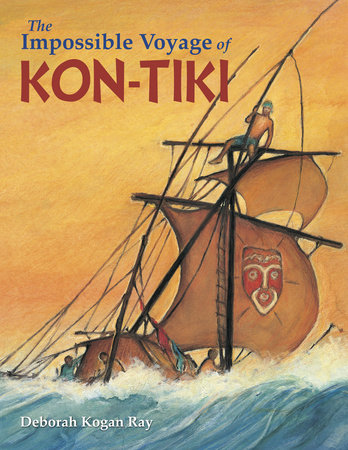

The Impossible Voyage of Kon-Tiki
By Deborah Kogan Ray
Illustrated by Deborah Kogan Ray
By Deborah Kogan Ray
Illustrated by Deborah Kogan Ray
By Deborah Kogan Ray
Illustrated by Deborah Kogan Ray
By Deborah Kogan Ray
Illustrated by Deborah Kogan Ray
Category: Children's Nonfiction
Category: Children's Nonfiction

-
$16.95
Oct 13, 2015 | ISBN 9781580896207 | 7-10 years
-
Oct 13, 2015 | ISBN 9781607349068 | 7-10 years
YOU MAY ALSO LIKE

Where Is Yellowstone?

My Little Golden Book About Vikings

Julia Child: A Little Golden Book Biography

Pope Francis: A Little Golden Book Biography

Steven Spielberg: A Little Golden Book Biography

Martha Stewart: A Little Golden Book Biography

Jacques Pépin: A Little Golden Book Biography

Look and Cook Breakfast

National Geographic Kids 5-Minute Dinosaur Stories
Praise
Bucking expert opinion, a young Norwegian anthropologist sets out on a balsa log raft to show that pre-Columbian voyagers from South America might well have traveled to the Pacific islands.
Thor Heyerdahl’s 1947 voyage moved the dial from “impossible” to “possible,” but not to “probable,” and as the author herself admits in an afterword, there is still little credible evidence of any sustained westward migration. Nonetheless, the tale of that 4,300-nautical-mile journey makes a grand one. Ray’s prose describes how he sailed with his crew of five from Peru without escort through seas calm and wild, supplementing stored provisions with caught fish, braving months of sudden rogue waves and damaging storms on the way to a final shipwreck on a Polynesian reef. Ray uses watercolors to create soft-edged views of the raft and its small crew, varying her perspectives and her palette as much as possible to avoid potential monotony. One sunset image with the raft in the distance and a school of flying fish in the foreground is particularly effective. She heads her matter-of-fact narrative with quotes from Heyerdahl’s bestselling account on each page, closing with further commentary and a biographical note.
A low-key tribute to a now little-remembered expedition that is still capable of catching the imagination.
–Kirkus Reviews
When he was still in college, the Norwegian anthropologist Thor Heyerdahl lived for a year on the Polynesian island of Fatu Hiva and became fascinated with a question: where did the Polynesian islanders come from? Stone carvings on the island resembled statues found in South America, indicating, perhaps, “a connection between the Polynesian Tiki and the Incan god Kon-Tiki Viracocha.” Though skeptics scoffed at Heyerdahl’s idea (most scholars believed that Polynesia was originally settled from Asia), in 1947 he embarked on a 4,300-mile ocean voyage and proved that ancient Incan sailors could have reached the South Pacific by raft. In dramatic double-page watercolor spreads, Ray follows Heyerdahl and his five-man crew on their 101-day odyssey on a balsa-log raft. Emphasizing highseas adventure over theory, the story will capture the imagination of young readers with the drama of flying fish, gale-force winds, giant waves, and, ultimately, the raft’s fortuitous landing on an uninhabited Polynesian island. However, though the large-scale illustrations are visually appealing, they also limit the number of scenes in which to tell the story, and the long ocean voyage is over too quickly for young readers to get a true sense of the arduous quest. Back matter includes a more thorough discussion of anthropologists’ theories of populations and migrations and notes that Heyerdahl was one of the first to warn of pollution in the oceans and to advocate for a “green world.”
–The Horn Book Magazine
Using concrete language and evocative watercolors, Ray tells the story of anthropologist Thor Heyerdahl’s 1947 voyage to prove his hypothesis that the ancient people of Peru traveled by raft to settle in Polynesia. Heyerdahl and his five-man crew sailed on the Kon-Tiki, a raft made of hemp and balsa wood that was named for an ancient Incan god. Their equipment consisted of a sextant, shortwave radios, and cameras to document their travels, and they subsisted mostly on fish. This extraordinary 101-day passage began at a harbor near Lima, Peru, and ended on an uninhabited island in Polynesia. Excerpts from Heyerdahl’s own descriptions of frightening storms and calm and lonely days at sea appear in bold type on almost every page and greatly enhance the author’s slightly dry narrative. A colorful map of the voyage on the endpapers complements the text. A short section, “Aftermath of the Impossible Voyage,” explains that Heyerdahl and the crew were hailed as heroes for proving that a primitive craft could cross the Pacific Ocean—but recent DNA studies have not proven the Heyerdahl theory. A one-page biography of Heyerdahl is appended. VERDICT An intriguing and useful account of a remarkable journey.
–School Library Journal
21 Books You’ve Been Meaning to Read
Just for joining you’ll get personalized recommendations on your dashboard daily and features only for members.
Find Out More Join Now Sign In










